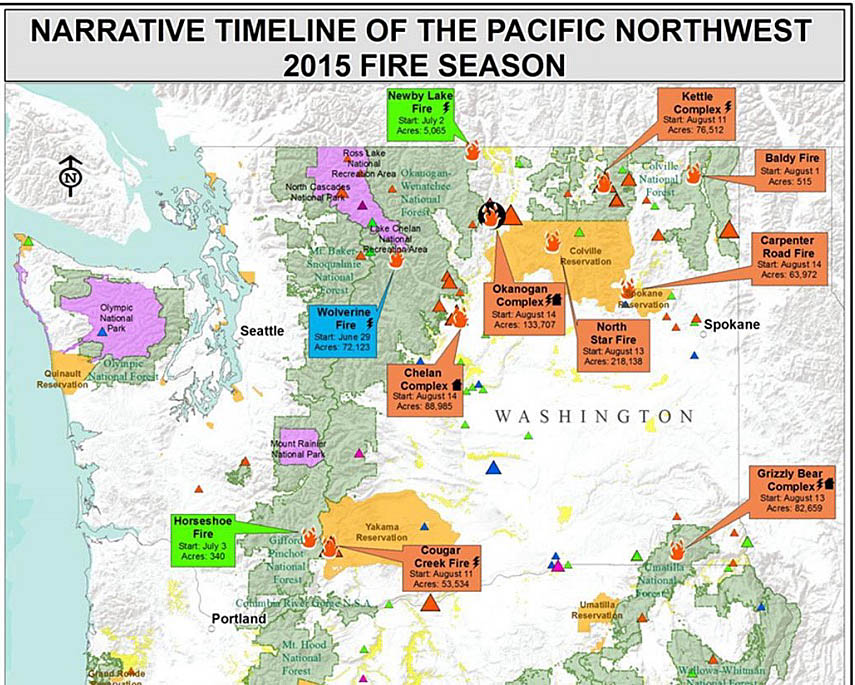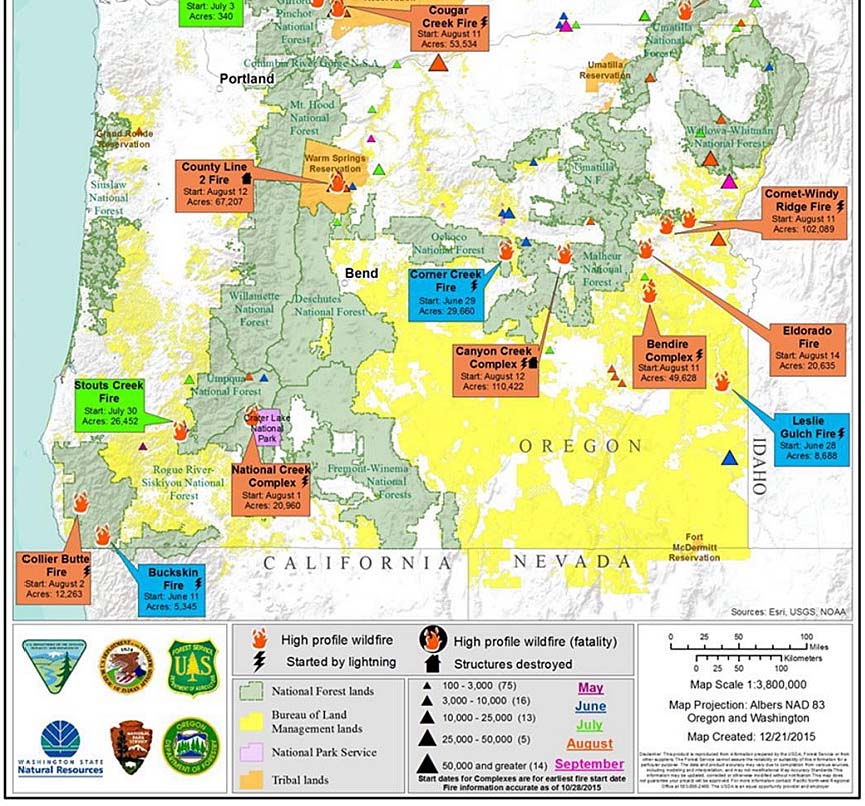Photo above: Firefighters observe the Cougar Creek Fire southeast of Mt. Adams in southern Washington in 2015. From InciWeb.
The U.S. Forest Service has produced an exhaustive summary and review of the 2015 wildfire season in what they call their Pacific Northwest Region — what the interagency community calls the Northwest Geographic Area — Oregon and Washington.
The report is huge, 281 pages. In addition to general information about the fire activity, it includes sections about weather, air quality, technology, and summaries of 28 fires with 14 of those being covered in greater detail than the others.
The main 281-page report can be be found here (it’s a LARGE file). There is another version they call an “Interactive Story Journal” which provides summary information from the main report as well as interactive web maps, videos, and numerous photos as well as “time-enabled fire progression maps” for selected fires.
Below are some excerpts from the report:
****
Most Severe Fire Season in Modern History
The 2015 fire season in the Pacific Northwest was the most severe in modern history from a variety of standpoints. Oregon and Washington experienced more than 3,800 wildfires (almost 2,300 in Oregon and more than 1,500 in Washington) that burned more than 1,600,000 acres (more than 630,000 acres in Oregon and more than 1,000,000 acres in Washington)—including 1,325 fires representing 507,000 acres on U.S. Forest Service lands (information as of September 30, 2015).
Initial Attack was successful in rapidly containing all but about 119 of these fires. This response represents an almost 97 percent Initial Attack success rate. Approximately 50 of these fire escapes occurred during a ten-day period in mid-August when numerous Large Fires (a wildfire of 100 acres or more in timber or 300 acres or more in grass/sage) were already burning in the Pacific Northwest. During this time, the Northern Rockies and Northern California were also experiencing unusually high numbers of wildfires. This situation limited the ability to rapidly obtain Initial Attack reinforcements as well as almost all types of firefighting resources needed for Large Fires.

Tragedy Strikes
Tragedy struck on August 19 when three U.S. Forest Service firefighters were killed while attacking a fire on private land near Twisp, Washington.
During this severe fire season, approximately 675 structures were lost. While well over 16,000 structures were threatened, most were saved from loss by aggressive suppression actions.
2015 Fire Season Milestones
- In August, to help support Washington State’s fires, the Emergency Support Function 4 (ESF4) was activated by the Federal Emergency Management Agency (FEMA).
- The Emergency Conflagration Act—that authorizes the Oregon Office of the State Fire Marshal to mobilize structural firefighters and equipment to assist local resources battling fires—was invoked by the Governor of Oregon on July 30 in response to the Stouts Creek Fire, on August 13 for the Cornet Fire and Windy Ridge Fires, on August 14 for the Canyon Creek Fire, and on August 20 for the Grizzly Bear Complex.
- The Washington State Fire Service Mobilization Plan is implemented to provide personnel, equipment, and other logistical resources from around the state when a wildland fire or other emergency exceeds the capacity of local jurisdictions. In mid-August, the Chief of the Washington State Patrol authorized such a state-declared mobilization on the Carpenter Road Fire, the Kettle Complex, and the Okanogan Complex.
- The Pacific Northwest Region had the highest priority in the nation for firefighting resources during these dates: July 25 and 26, August 14-31, and September 8-13.
- The Pacific Northwest Region was under a Preparedness Level 5 (the highest, most severe level) from August 13 through September 4.
- The greatest number of uncontained fires occurred on August 18: 25 Large Fires totaling 822,512 acres in the Pacific Northwest Region (105 Large Fires totaling 2.2 million acres nationally).
Weather
The first six months of 2015 were the warmest first six months of any year over much of Oregon and Washington since record keeping began in 1895.
These record-warm temperatures observed during the winter and spring, coupled with below-average precipitation, led to an exceptionally poor snowpack throughout the winter and spring.
From June 1 through September 15, a total of 51,019 lightning strikes were recorded over Oregon and Washington. The average for fire seasons from 2000-2014 through September 15 is 78,775 strikes. While the number of the 2015 strikes was below this average, the background of drought in 2015 enhanced the ability for lightning strikes to ignite multiple fires in short periods of time.
Air Quality
Special “Air Resource Advisors” were deployed to multiple incidents. The U.S. Forest Service Washington Office Fire and Aviation Management staff is developing the Wildland Fire Air Quality Response Program which deploys specially trained technical specialists—known as Air Resource Advisors (ARA)—and a national cache of smoke monitors available by request.
During the 2015 fire season, these Air Resource Advisors were deployed to multiple incidents across the Pacific Northwest Region. The Air Resource Advisors produced a standard, daily product of predicted air quality conditions to provide smoke impact forecasts to county health departments and local communities. These special air quality forecasts then enabled precautions to be taken to limit health impacts from smoke.
In addition, impacts to transportation corridors, airports and other smoke-sensitive sites were evaluated and made known to agencies responsible for their management. The Oregon and Washington “smoke blogs”—oregonsmoke.blogspot.com and wasmoke.blogspot.com—also provided a primary venue for communicating with the public and air quality partners.


Thanks and a tip of the hat go out to Kelly.



Killing 3 firefighters is not acceptable….